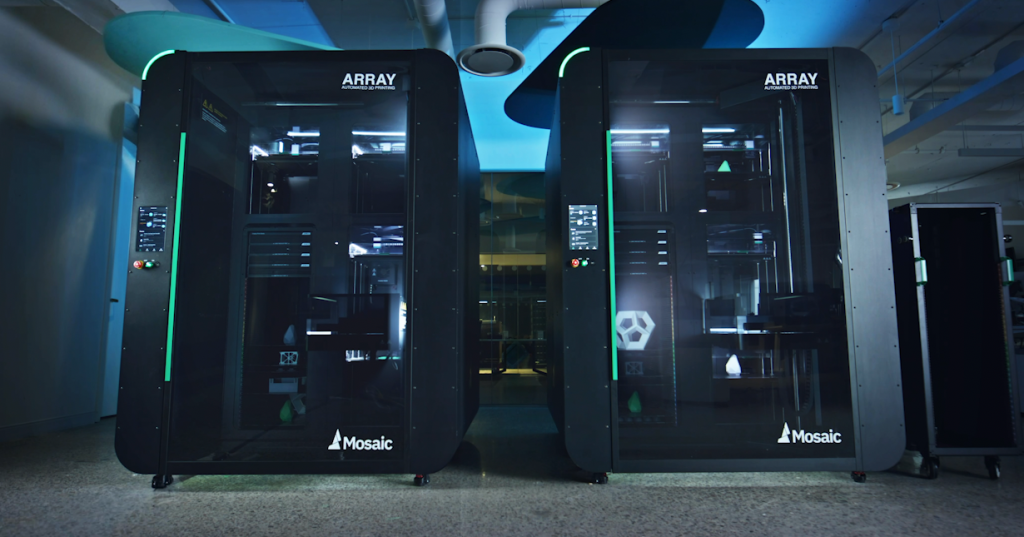3D printing company Mosaic Manufacturing has announced the shipment of its Array polymer 3D printers.
Following this, beginning on November 16th, the manufacturer will initiate shipments of its Element and Element HT 3D Printers. According to Mosaic, Array is the first fully automated polymer 3D printing system designed for the industrial market. The system incorporates patented automation technologies, including bed changeover, material automation, AI-powered monitoring, and software operation automation. Each Array unit comes with four Element or Element HT 3D printers and starts at a price point of $79,999 USD.
“Until now, the use of 3D printing at scale has been blocked by high part costs and challenges scaling capacity. With Array’s range of automation features designed for production volumes, it is exciting to see a wide range of companies reevaluate and move forward with additive manufacturing at scale,” Mitch Debora, Mosaic’s Co-founder and CEO.
Mosaic’s 3D printing offering
Mosaic’s Array system is the first of its kind, capable of 3D printing thousands of polymer parts on-site without requiring constant human intervention, says the company. This system aids in reducing lead times for manufacturers and offers increased flexibility and resilience in supply chains. Additionally, it provides companies with the opportunity to re-establish their polymer supply chain, enhance the skills of their teams, and construct advanced manufacturing capacity, enabling them to remain competitive for years to come.
The Element 3D printer is equipped with 14”x14”x14” (355mm x 355mm x 355mm) spacious build volume and individually temperature-controlled chambers, allowing users to work with both high-temperature and low-temperature materials simultaneously. Additionally, users can opt to add a heated chamber and high-temperature hot end to print advanced materials. The heated chamber also contributes to the production of stronger parts. Element/HT comes equipped with Mosaic’s reusable Material Pods, which monitor filament usage, type, humidity, and temperature for both Mosaic and third-party materials.
Mosaic’s Canvas Edu platform offers educational institutions a simplified and automated means of managing 3D printing workflows for students. Serving as a control center for Array, Canvas facilitates tasks such as slicing parts, managing print queues, and monitoring completed builds. Collaboration is made easy through Canvas, allowing team members to share files and run prints efficiently. Canvas Edu streamlines the process for educational institutions, particularly in handling the submissions of a large number of students.
The initial production run for Array and Element has achieved significant success, with over 80% of the units sold. The products are set to be delivered to customers by the end of 2023.
“Array has set a new standard for the lowest and most predictable production 3D printing costs at scale with a plug-n-play production platform. The pace of adoption around the world is exciting and will help usher in a new generation of green, nimble, and onshore production,” said the CEO.

Technical specifications of Mosaic’s Array 3D printer
| Construction | Durable All Metal Motion Systems, Aluminum Outer Chasis |
| Layer Resolution | 20-230 Microns |
| XYZ Resolution | X.Y, X.Y, X.Y micron |
| Build Volume | 4 Modules of 14″x14″x14″ (2744 Cubic Inches Each) |
| Build Speed | < XY mm3/s |
| Build Plate | Spring Steel Build Plate, Automatically Changed via Internal Robotic Arm |
| Heated Bed | 0-120°C |
| Thermal Chamber | 0-80°C |
| Nozzle | 0.4mm Hardened Steel Nozzle |
| Max Nozzle Temperature | 300°C-500°C |
| Fume Extraction | Integrated exhaust fan with optional external fume extraction hook-up (notincluded). |
| Print Modules | 4 x Independent Element HT Array Modules |
| Build PlatformChanging | Automated with Array build plate changing robotics. |
| Max Robotics Travel | X: xy m/s, Y: xy m/s, Z: xy m/s |
| Available PrintMaterials | Mosaic PLA, Mosaic PETG, Mosaic Saphire, Mosaic Matrix, MosaicSoluble M1, Mosaic ABS, Mosaic Breakaway, Mosaic PEEK, Mosaic PEKK,Mosaic Ultem 9085, Mosaic ESD |
| Material Type | Mosaic Certified, Other Materials Not Supported |
| Material Bays | 4 Modules of 8 x 2kg (16kg per module)32 x 2kg in the entire system (64kg of material) |
| Software | Canvas Array, Canvas Teams |
| Connectivity | WIFI, LAN (Ethernet) |
| Operating Footprint | 1.6m x 3.2m x 2.1 m (5’ 2” x 11’ 2” x 5’ 2” ) |
| Power Required | 100V – 240V AC, 20A |
| Certifications | cTUVus, EN62368-1: 2014, EN55032: 2015, EMC, CE, RoHS |
| Warranty & Service | 1 Year |
Voting has now started for the 3D Printing Industry Awards 2023. Cast your vote now!
What does the future of 3D printing for the next ten years hold?
What engineering challenges will need to be tackled in the additive manufacturing sector in the coming decade?
To stay up to date with the latest 3D printing news, don’t forget to subscribe to the 3D Printing Industry newsletter or follow us on Twitter, or like our page on Facebook.
While you’re here, why not subscribe to our Youtube channel? Featuring discussion, debriefs, video shorts, and webinar replays.
Are you looking for a job in the additive manufacturing industry? Visit 3D Printing Jobs for a selection of roles in the industry.
Featured image shows Array polymer 3D printers. Photo via Mosaic Manufacturing.



